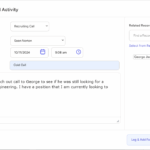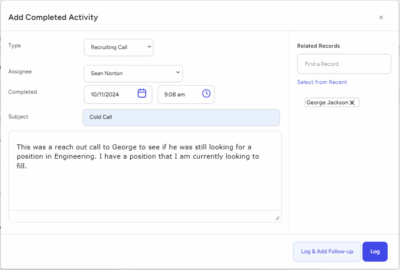There’s nothing like the beginning of a relationship with a new client. (It’s almost as much fun as when you first started dating as a teenager!) There might not be butterflies, but there are job orders. And those are better. But wait . . . what about the initial recruitment meeting?
What is a recruitment meeting or intake meeting?
What initial recruitment meeting, you might be asking? Thank you for asking. But let’s start at square one, shall we?
A recruitment meeting is the initial meeting between a recruiter and officials of the employer, during which all parties involved discuss the strategy and goals of the recruiting and hiring process. This meeting is also called a kickoff meeting or an intake meeting.
Intake meeting with the hiring manager
A recruitment meeting can involve a number of different people. First, of course, is the recruiter. However, there are different types of recruiters. If the company employs internal recruiters or corporate recruiters, they could be involved in the meeting. However, if the organization employs third-party recruiters, then they would be involved.
And on the employer’s side, there’s the Human Resources (HR) department. Larger companies and organizations have entire HR departments devoted to the activities associated with hiring. A hiring manager or hiring authority might also join the party. A hiring manager is a supervisor or decision maker in charge of hiring within a specific department in an organization. They may work with the HR personnel or independently of them.
So there might be one HR representative at the recruitment meeting, or one HR representative and a hiring manager, or two HR representatives and the hiring manager. Then again, there might only be HR representatives. Or only a hiring manager without any HR representation. It depends upon the employer. Generally speaking, though, the more people attending the intake meeting, the better.
There are basically three kinds of recruitment meetings:
- A meeting that revolves around the relationship that the recruiters will have with company officials.
- A meeting that revolves around a specific search that the HR representatives and/or the hiring manager want to fill.
- Last by not least, a meeting that revolves around both the relationship that the recruiters will have with company officials and a specific search those officials want to fill.
Recruitment kickoff meeting logistics
So now let’s talk logistics. When does the recruitment meeting take place? Once again, that depends upon the situation. Regardless of whether it involves internal recruiters or agency recruiters, it could take place because of a search or before the start of a search. Below are some likely scenarios:
- A company or organization hires internal recruiters. Those recruiters want to have a recruitment kickoff meeting immediately, regardless of whether or not that meeting will involve specific searches.
- Those internal recruiters might then conduct a recruitment meeting for every search thereafter. This is regardless of the brevity of the meetings or who might be involved.
- A company or organization secures the services of a third-party recruiting agency. The agency owner then wants to have a recruitment kickoff meeting with the appropriate company employees. The meeting could involve the relationship between the agency and the employer or both the relationship and a specific search. (Usually when a company secures the services of a third-party recruiting agency, a specific search has convinced its officials to do so.)
- The agency recruiters might then conduct an intake meeting for every search thereafter, similar to what internal recruiters would do.
Recruitment intake meeting: a study in geography
Does a recruitment intake meeting have to take place in person? Or can it take place over the phone? How about Skype? All of the above are correct. Naturally, an in-person meeting would be best. However, that’s not always possible (or even necessary in the event of a meeting to discuss a specific search).
There are also geographical considerations. For example, if an agency recruiter works a national market and they live in Florida, they might not travel to California for a recruitment meeting with a new client. Then again, they might, if they consider the client to be that important. Personal preference does play a role. Once again, below are some likely scenarios:
- An internal or corporate recruiter would meet in-person for every intake meeting, since they work for the same employer. And quite possibly, work in the same building.
- An agency recruiter might meet their client in person for the first recruitment meeting, but then use the telephone or Skype for future intake meetings.
- An agency recruiter might meet their client in person for every recruitment meeting they have. Agencies that work primarily a regional market are more likely to take this approach.
So now you know the possible ins and outs of the recruitment intake meeting. They come in different forms and serve different purposes and are conducted in different ways. That’s all fine and dandy. However, for the purpose of this particular blog post, we’re going to focus on the initial recruitment meeting. In other words, we’re going to focus on a recruitment agency’s initial meeting with a client. Although This meeting does not focus on a specific job opening or search, but instead on the relationship between the agency and the client.
Recruitment meeting agenda
To help us, we’re going to draw upon the wisdom of recruiting industry trainer Gary Stauble. Gary is the principal consultant for The Recruiting Lab, a coaching company that assists firm owners and solo recruiters in generating more profit in less time.
According to Gary Stauble, below are nine steps for conducting a strong recruitment meeting:
1. Rehearse your presentation.
Rehearse a verbal and mental presentation of your meeting. Memorize the key points that you want to cover. Nothing adds to your self-confidence like preparation and rehearsal.
2. Set the framework for the meeting.
Say something like this to your client: “I’d like to ask you some specific questions to see if we can be of service, then I can answer any questions you have about us. We’re probably looking at 30 to 40 minutes. Does this work for you?”
3. Use intense listening.
The great thing about client meetings is that what the client really wants is simply to be heard and understood by you. This means that you must be an intense listener. Follow this simple guideline: they talk 80% of the time.
4. Ask quality questions to expose their wounds and gather information.
Ask “what” questions like these:
- What do you like most about your current relationships with other search firms?
- What do you like least about your current relationships with other search firms?
- What qualities do you look for when you are selecting a search partner?
- What are your perceptions about us?
- What do you know about our firm?
- What strengths do you perceive our firm to have that led you to invite us to speak with you?
Asking these types of questions would almost certainly reveal the prospect’s misconceptions. It will also help you to influence their decision-making. Before you try to influence a prospect’s decision-making, find out what they’re already thinking and why.
Now, you might be wondering, “Hey, what if this initial meeting does involve a search? Which questions should I ask then?” That’s a fair question. Actually, that’s two fair questions. And we have the answer(s).
In fact, we have just about ALL of the questions that a recruiter should ask during an intake meeting, regardless of whether it’s a kickoff meeting or a meeting about a specific search. You can find those questions in the blog post, “Important Recruiter Questions to Ask a Hiring Manager.”
5. Find the gap between what they really want and what they have.
This is Sales 101. You must find the gap and then sell only to the gap (need) that they describe. Change your presentation to specifically address their concerns and needs.
6. Give a brief bio of yourself and your firm.
You can use all or some of the following:
- Recruiter and company background
- Describe results (save time, save money, increase quality of hires)
- Scope of your contacts – this could include any recruiting network memberships that you’re a part of, etc.
- Niche expertise
- Candidate-screening process
7. Review your search process.
Briefly walk your client through your search process. Include the number of steps you follow and give them a hard copy. Be sure to follow each step with this statement: “And the benefit to you is . . .”
8. Set expectations.
If the client has agreed to work with you, be sure to pre-close issues of timely feedback, any recruiter questions for hiring managers and their contact info, open communication, etc., so that you have set the tone for the relationship.
9. End the meeting.
End the meeting with this question: “Do you have any concerns about our ability to perform this search? If so, I’d like the opportunity to address them now.” Finally, be yourself and have fun with this. Be sure to approach the meeting from a position of preparation, market knowledge, and confidence. These attributes are attractive to clients. Then, use your recruiting software and other tools to deliver the results you’ve uncovered.
Now that you know these steps, you’re ready to have a strong recruitment meeting with a client (or a potential client). And don’t forget: for maximum impact, you should both start your meeting strong and end it strong. That’s the best way to remain memorable in the minds of those attending the meeting. Now go fill those searches!
Top Echelon offers a free monthly webinar as part of its Recruiter Coaching Series. After the webinars are over, we post the recorded version of the webinars in our Recruiter Training Library. These webinars touch upon a variety of recruiter-related topics. These topics deal with both candidates and clients. As always, our goal with these webinars (and corresponding videos) is to help recruiters make more placements.
Gary Stauble has two videos in the Top Echelon Recruiter Training Library. These videos are listed below. Click on the title of each video for access:
- “The #1 Strategy for Billing More and Working Less”
- “3 Simple Strategies for Boosting Your Performance”
In addition to training and webinars, Top Echelon offers other recruitment solutions. These solutions include the following:
- Big Biller applicant tracking software
- Top Echelon split network
For more information about Top Echelon and the products and services that it offers, visit the Top Echelon website by clicking here.








